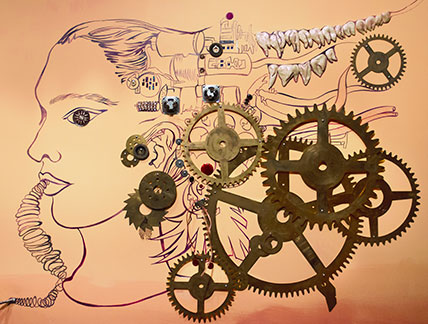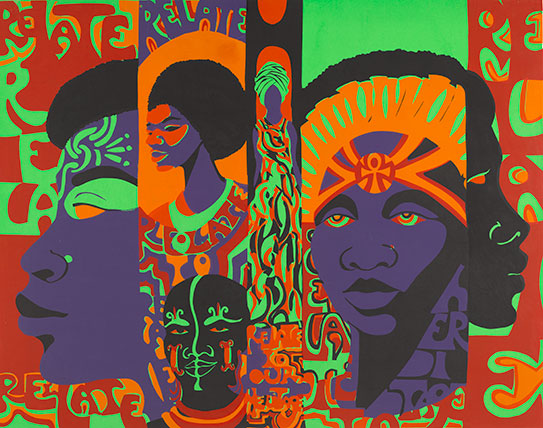
Chitra Ganesh (American, born 1975). Eyes of Time (detail), 2014. Mixed-media wall mural. Courtesy of the artist and Gallery Wendi Norris, San Francisco. © Chitra Ganesh. Photo: Jonathan Dorado, Brooklyn Museum

Chitra Ganesh (American, born 1975). Eyes of Time (detail), 2014. Mixed-media wall mural. Courtesy of the artist and Gallery Wendi Norris, San Francisco. © Chitra Ganesh. Photo: Jonathan Dorado, Brooklyn Museum

Egypt. Seated Statuette of Sakhmet, 664–332 B.C.E. Bronze, 7 × 13⁄4 in. (17.8 × 4.5 cm). Brooklyn Museum, Charles Edwin Wilbour Fund, 08.480.28
The Egyptian goddess Sekhmet—whose name comes from sekhem, an ancient Egyptian word for power—echoes the fusion of power and fearsome femininity ascribed to both shakti and Kali. Also a warrior, Sekhmet is associated with fire, healing, and menstruation. In mythic tales both Sekhmet and Kali are connected to blood, death, destruction, and protection, and to fierce animals such as lions and tigers. These qualities contrast with characteristics typically idealized in women today and point to the formidable roles played by the ancient goddesses.
—CG

Indian. The Goddess Matangi, circa 1760. Opaque watercolor, gold, and silver on paper, 111⁄4 x 161⁄4 in. (28.6 × 41.9 cm). Brooklyn Museum, Anonymous gift, 84.201.9. Photo: Brooklyn Museum
In this painting, the many-armed goddess Durga rides in the center on her tiger, while her even fiercer incarnation, Matangi, is shown at the upper left holding a severed head and a sword. Along with Kali, they are among the ten fearsome forms of female divinity known as Mahavidyas. By picturing overlapping avatars, paintings such as this one indicate the fluidity between and interrelation of a variety of goddess forms. This plurality also allows various social groups to identify with female divinity through their preferred avatar. For example, Matangi, a marginal figure in the pantheon, has often been associated with worship among lower castes.
—CG

Kiki Smith (American, b. Germany, 1954). Untitled from Banshee Pearls, 1991. Lithograph, 221⁄2 x 301⁄2 in. (57.2 × 77.5 cm). Brooklyn Museum, Emily Winthrop Miles Fund, 1999.17.3. © Kiki Smith
Kiki Smith is known for her ongoing engagement with bodily matter and the female form, often through fairy tales and folklore. The title of the set to which this lithograph belongs—Banshee Pearls—combines terms with very different connotations. Pearls have long signified upper-class elegance and femininity, while a banshee is a female spirit in Irish mythology whose chilling screams and ghostlike pallor are omens of death. The word banshee is still used to describe women or girls who are seen as wild or inappropriately behaved. Here, repeating deathlike masks of a female face ask the viewer to consider how female power relates to beauty and the grotesque.
—CG

Barbara Jones-Hogu (American, b. 1938). Relate to Your Heritage, 1971. Screenprint, 34 × 43 in. (86.4 × 109.2 cm). Brooklyn Museum, Gift of R. M. Atwater, Anna Wolfrom Dove, Alice Fiebiger, Joseph Fiebiger, Belle Campbell Harriss, and Emma L. Hyde, by exchange; Designated Purchase Fund, Mary Smith Dorward Fund, Dick S. Ramsay Fund, and Carll H. de Silver Fund, 2012.80.26. Photo: Sarah DeSantis, Brooklyn Museum
Relate to Your Heritage combines the visual language of psychedelic posters with multiple fragments of African American female figures, constructing a culturally specific articulation of femininity and power. Both this work and Eyes of Time point to the importance of the feminine form in linking a collective mythic history to present-day autonomy and power. Barbara Jones-Hogu was a founding member of AfriCOBRA, a movement of visual artists formed in 1968 that sought “an approach to image making which would reflect and project the moods, attitudes, and sensibilities” of African American self-determination.
—CG

Shoichi Ida (Japanese, 1941–2006). Between Vertical and Horizon—Descended Triangle No. 6, 1987. Color aquatint, sheet: 26 × 225⁄8 in. (66 × 57.5 cm). Brooklyn Museum, Gift of Nancy Genn, 1991.215.9. © Estate of Shoichi Ida
This print evokes one of the key visual metaphors associated with Kali, who is sometimes depicted as pure geometric abstraction in the form of a yantra rather than as a multilimbed goddess. Yantras are spiritual visualization instruments specific to the philosophy and ritual of Tantra, a sect of both Hinduism and Buddhism. The Kali yantra is a red and black diagram of interlocking triangles, lotus petals, and geometric forms, and is one of several symbolic representations of shakti (female divine energy). The inverted triangle also resonates with the contemporary use of pink and black triangles as symbols of queer identity.
—CG

Chitra Ganesh (American, b.1975). Page 1 from Tales of Amnesia, 2002. Inkjet print, 81⁄2 x 7 in. (21.6 × 17.8 cm). Courtesy of the artist and Gallery Wendi Norris, San Francisco
This twenty-four-page comic book is inspired by the widely read Amar Chitra Katha (ACK) series of comics that visualized the stories of South Asian history and myth for audiences in Asia and its diaspora. Tales of Amnesia features multiple narrative voices, fragments drawn from vintage and current ACK comics, and shape-shifting heroines who experience violent bodily transformations. These narrative devices allude to the power of multiple forms of femininity that coexist within the same frame and, at times, within a single being, as well as to darker aspects of Kali.
—CG

Chitra Ganesh: Eyes of Time
December 12, 2014–July 12, 2015
Exploring ideas of femininity, empowerment, and multiplicity, Brooklyn-based artist Chitra Ganesh draws inspiration from the Museum’s encyclopedic collection, including representations of the goddess Kali, to create a site-specific multimedia installation for the Herstory Gallery.
Chitra Ganesh: Eyes of Time centers on a monumental mural that takes Kali, the Hindu goddess of destruction and rebirth, and other figures from Judy’s Chicago’s The Dinner Party as starting points for portraying female power and plurality. The artist expands on this theme by showcasing works from our Egyptian, Indian, and Contemporary collections.
For more than a decade, Ganesh has used the iconography of mythology, literature, and popular culture to bring to light feminist and queer narratives. One of her first major works, Tales of Amnesia (2002)—a zine inspired by Indian comic books that the Museum acquired out of our 2004 exhibition Open House: Working in Brooklyn—is also on view.
Chitra Ganesh: Eyes of Time is organized by Saisha Grayson, Assistant Curator, Elizabeth A. Sackler Center for Feminist Art, Brooklyn Museum.
This exhibition is made possible by the Elizabeth A. Sackler Foundation.